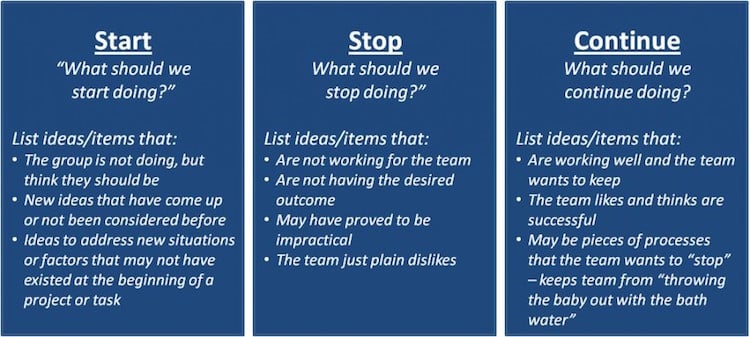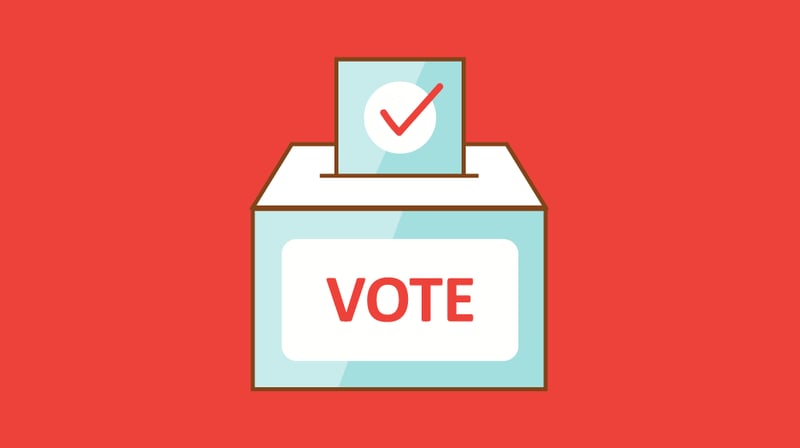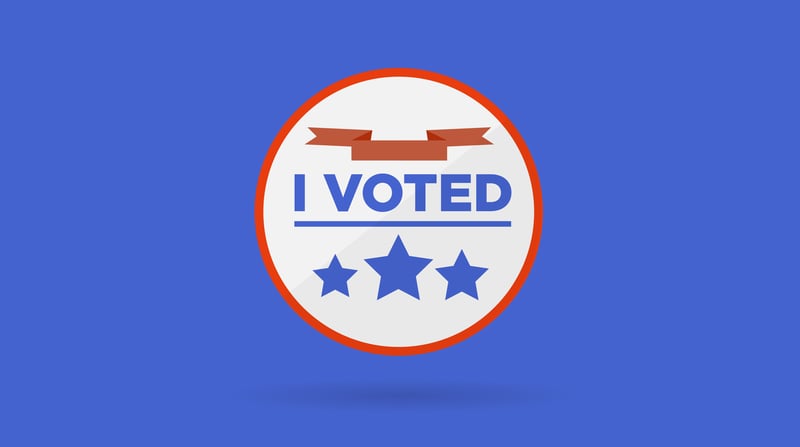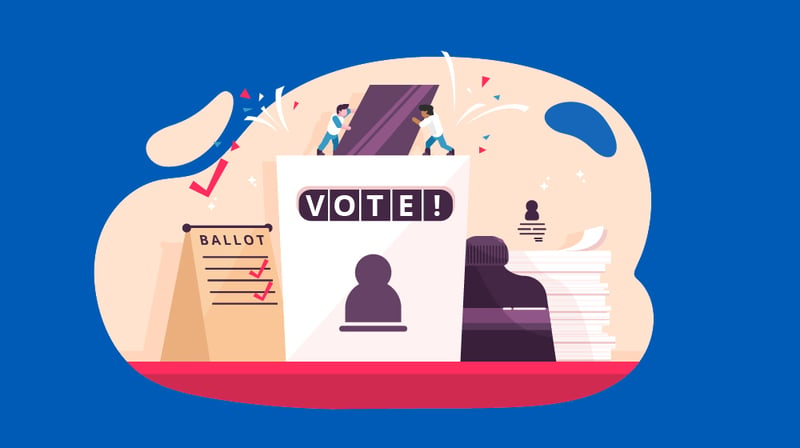Preparing for an SGA election on a college campus can be both competitive and a lot of fun.
At one point or another, students need new inspiration to run student government association (SGA) elections and decide how they’re going to market themselves as a candidate in the running.
It doesn’t matter if you’re an SGA veteran who has navigated years of organizing and implementing student government campaigns or elections: new perspectives help create change.
Looking at examples and sharing ideas helps you become more creative, spark new ideas, and makes you stand out from other SGA candidates you’re up against. Read on, fellow student government friends, and get inspired to make your SGA elections or campaign stand out from the rest.
Running Campus Elections
Take some time to reflect on past election success and engagement.
What made them successful? Where can you improve this year?
When I advised a student organization, I often utilized the Stop, Start, Continue change model to understand where we needed to focus our efforts most. It’s a really helpful technique whether you’re a student leader running events and looking for feedback, or an advisor looking to help your student org optimize processes overall.
Here is an example of how the Start, Stop, Continue model works:

image from people-results.com
This is a great time to build a strong relationship with your SGA advisor and ask them to help facilitate this conversation. After all, your advisor is most likely a campus administrator who can help your team understand boundaries, rules, and working with other campus stakeholders.
Creating Election Goals & Vision ?
Continuing off of your Stop, Start, Continue conversation, it’s important to align and incorporate new ideas into your vision for the overall election.
What is the purpose of campus elections? What do you want to accomplish?
When looking to create specific goals, here are a few areas of where to start:
- Voter accessibility
- Turnout the day(s) of the election
- Constructive discourse (monitoring, listening, providing events and spaces to engage)
Utilize SMART (Specific, Measurable, Attainable, Realistic, Timeline) goal planning while reflecting on the areas you chose to make sure they are realistic and you’ll be able to delegate and accomplish them as a team:
S – Each goal should be specific. Include dates, resources, people, and specific dollar amounts you’ll need.
M – Each goal should be measurable whether by the date, dollar, or an appropriate unit. For example, you may want to increase social media engagement around the elections with off-campus students. Create goals around engagement rates on each social media platform and the steps you’re going to take to get there.
A – Your goals should be attainable for each area. List example or exact steps with your team of how you’re going to reach your goals.
R – If goals are realistic and relevant to all of your lives on a personal level, you’re more likely to achieve them. Identify resources you will need to achieve them. Set follow up dates or time during meetings to review and revise these discussions.
T – You’ll need a specific timeline to accomplish your goals. There will never feel like there’s enough time or manpower to accomplish your goals. Prioritize your goals realistically and understand what needs to come first. Don’t leave important tasks to the last minute.
Clarifying the Process 
During or after goal creation, it’s important to dictate a process around elections to encourage the best candidates to run and increase voter turnout.
When are applications due? Signatures for candidates? How long can candidates campaign? How long do polls stay open? Can students vote electronically? How do you make students aware that they can run? Is the process clear?
The biggest excuses I hear when it comes lack of participation in student government elections includes:
‘I didn’t know how to vote’ ‘I didn’t know where to vote’ and ‘I didn’t realize the deadline’
One of the best ways to clarify election dates and processes is by adopting a student government election software that can get the word out for you.
Example:
I often see student leaders struggle to get an ‘off-campus’ vote. Off-campus students may not have class on the day of the election and may not have the time to make it to campus to vote. With a mobile-friendly software like Presence, students can vote from the comfort of their own space (i.e. home or work) and participate in elections. Utilizing a feature like campus forms, student government leaders and advisors can verify voters and ensure security around the voting process, even if students can’t show up in-person.
Election Tips for Candidates
Hoping to be class president, secretary, treasurer, student trustee, or senator-at-large?

While we’ve already come up with tips and advice on five things to consider when you run for a student government position, we thought we’d take the time to expand upon them here and give you more takeaway ideas.
Determining Your Why ?
Reflect on your overall mission and determine how you will best communicate your goals. In my experience, I’ve seen each candidate outline a few areas they feel dedicated to on-campus and how they’re going to, for example, improve campus resources.
Why do you want to run for office? Who are you representing? What makes you the best candidate for the position? How will you leave a positive impact on campus?
Example:
Presidential nominee and student of Florida State, John Russo, communicated his priorities after personal experiences on campus and realizing that he could relate and help a large percentage of the student population.
Russo explained that he wanted to work alongside the counseling center on campus to help students dealing with mental health concerns and depression to, “break the stigma around mental health”. One of his specific goals included incorporating a session at new student orientation where incoming students could learn more about depression, how to identify behaviors and signs, and campus resources to utilize if they need to ask for help.
He realized that campus resources are often underutilized and students aren’t aware they’re available, “student’s aren’t getting their money’s worth by paying fees [for campus resources].”
Organizing an Election Squad ?
What do we mean by squad? The people who will ‘ride or die’ with you until your campaign is over.
Building a coalition of students who share your platform is no easy task. Find students who share similar goals and practice having conversations with new students you’ve never met to on-board them to your ideas. Past student government nominees and candidates have explained the benefit of engaging with and on-boarding at least 100 student supporters who can help you campaign.
At the minimum, ask close friends or student leaders to help you organize your campaign by assigning them campaign roles and responsibilities. This will help take some of the campaign tasks off of your plate.
Examples:
- Create a campaign manager role (someone who is familiar with rules, regulations, and timeline)
- Coalition builder role (provides specific communication to student organizations and groups)
- Communications coordinator role (organizes and plans social media messaging and awareness)
- Marketing/design role (someone who is familiar with brand management, creating engaging flyers, helps create campaign slogan)
Christian Haas, former Student Body Vice President and President of the Senate of University of South Florida, St. Petersburg campus shares,
Create a shared vision for your campus community by bringing students and organizations into the process before the campaign. Collaborate on the creation of your platform. Students support what they create, so if they help develop the platform, they’re more likely to support it.
Haas also explains the benefit of managing student volunteers,
Identify simple, quick ways for volunteers to support you. Whether it be campus announcements or handouts. Always give tasks (large or small) to students who show up to your meetings.
It’s more than just inviting friends to join in on your election vision. It’s important to build a coalition of student groups and people who truly understand the goals you want to accomplish while in office. For example, utilize people who are ‘on the ground’ and who will inform their immediate networks.
Example:
Last year, Florida State University held competitive elections with their main political parties ‘Vitality’ and ‘Advance’. Each party had overarching areas they wanted to communicate and improve on campus. By creating a platform and communicating their shared ideas, it made each party a stronger team when it came time to campaign.
Changes the Vitality party were committed to included:
- Establishing a sense of ‘home’ on-campus
- Free feminine products (i.e. tampons)
- Building cohesiveness among the marginalized community
While the Advance party communicated they’re expected changes:
- Allow EBT (electronic benefit transfer) for students
- Negotiate a student discount with UBER
- Introduce Redbox to campus
- Start a hammock rental program
- Allow students to substitute parking fees with community service hours
Best advice: stick to a few areas that you really want to change that are realistic.
Participate and Monitor Social Media Conversations ?
Using social media platforms as a tool during SGA elections is an awesome way to get your slogan and name to go viral around campus. YouTube channels for campaign commercials and Instagram stories are just a few ways you can turn your followers into active voters for your campaign.
When you make students curious about your student government campaign, they will visit your social media profiles often making sure they don’t miss an update. Make sure you’re serve up engaging content that will drive more students to get to know more about YOU that they won’t be able to resist.
Margaret Mulkerrin, a student at Wake Forest University, leveraged social media to her advantage. She explains,
I would say the best thing about social media is that it lets me continue a conversation I can’t have in the classroom. I see people all day, but the real stuff happens when people are procrastinating online.
Mulkerrin utilized campaign videos, a Facebook page, and hashtag to create awareness around her campaign like #HouseofMarge and when she won celebrated with #MargeinCharge.
Example:
If you’re an on-campus resident student and you want to reach off-campus students you may choose to find them via a campus hashtag on Twitter, Facebook group, or student engagement platform.
Create and distribute engaging and consistent content like…
- A catchy video on YouTube or Vimeo
- Witty or simplified hashtags that can be utilized on Twitter, Instagram to increase your campaign or platform following (i.e. #PickFlick, #Vitalized)
- Free social media giveaways like concert tickets or a parking space (i.e. tag two friends to be entered into and follow us)
Social media practices help engage with students you may otherwise not reach. Although social media is a great facilitator of conversations online, at the end of the day students still say they want to be engaged with an SGA candidate face-to-face.
Engaging Face-to-Face With Voters ?
Eat, live, and breathe your campaign. Every time you attend class, venture across campus, and choose to engage with a campus representative is an opportunity to expand your network of support.
Meet as many people as you can and be aware of what a genuine interaction looks like for you. You may not be able to remember everyone’s name, but each student will remember how you made them feel and if your campaign message resonated with them enough that they will remember who you are and what you stand for to vote for you.
Example:
Organize a selfie campaign around elections to create brand and name awareness. It could be funny, inspiring, or informative. The main objective is to connect with as many students as you can and bridge your online and in-person community.
Plan specific times to explore campus: visit different resource spaces, offices, and student group meetings. Ask to speak for a few minutes to share your campaign platform.
Your Thoughts!
No matter the turnout of the election, use the ideas you’ve come up with to make your campus better. If you don’t win the spot, don’t feel your energy has been wasted, use the ideas and conservations to propel movement to make changes. You don’t have to be in the seat of Student Body President for your voice to be heard.
What are some tried-and-true practices you’ve utilized in organizing campus elections?
How have you differentiated yourself from the crowd when running your campus campaign?
We’d love to hear from you! Connect with us at @themoderncampus to continue the conversation.
Thanks for reading,
P.S. Thank you Christian Haas, our Engagement Specialist and Presence team member, for best practices when it comes to Student Government Elections and campaigns.





